[youtube:https://www.youtube.com/watch?v=9oETTQVGP1w]
For a moment, I really thought we were all going to die. Having waited for 30 minutes in lines snaking around the block, the audience for Cai Guo-Qiang’s April 7 explosion event, Mystery Circle, we stood jammed together, enclosed by a chain link fence next to MOCA’s Geffen Contemporary building, the air tense with anticipation. When Cai’s 40,000 rockets launched in unison, they formed a terrifying cloud of flames, heat, and noise that surged not upwards, but directly toward the crowd.
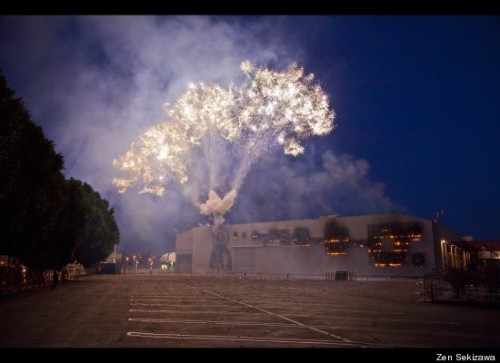
Cai Guo-Qiang, "Mystery Circle," April 7, 2012. Photo by Zen Sekizawa, courtesy Museum of Contemporary Art Los Angeles.
After glimpsing my own mortality, I could barely absorb the subsequent explosions of 100 so-called pyrotechnic UFOs – fireworks that hover and spin in the air—which launched from the ground, exploding against the museum wall to leave a smoldering design of circles mirroring crop circles. At the far end of the wall, Cai’s gunpowder mural ignited last, forming into the kitschy shape of a cartoonish “alien-god,” complete with conehead and cat eyes. Part of the impetus for Cai’s pyrotechnic art comes from a fascination with the human quest to fly, and his related interest in communing with extra-terrestrials. I had been skeptical about the sincerity of his latter exploration, but when my friend pointed to an X-Files fan poster on Cai’s studio wall, visible during his Season 3 Art21: Art in the Twenty-First Century segment, I began to think that his efforts might be earnest. And after experiencing the Mystery Circle explosion myself, I think it might actually work. If they’re out there. Ahem.
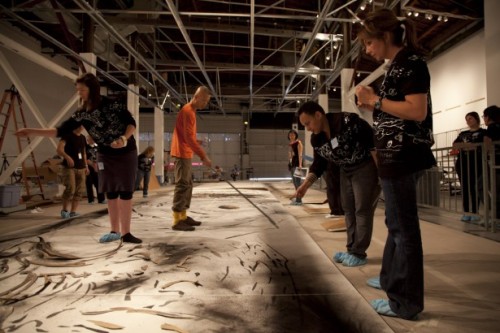
Cai Guo-Qiang working with volunteers to create "Chaos in Nature," Los Angeles, 2012. Photo by Joshua White, courtesy The Museum of Contemporary Art, Los Angeles.
In Cai’s interview with Art21, he compares his artistic process to making love. “From the very beginning of laying down the paper, it’s like laying down the sheets on the bed. And it’s a very long process, always working towards the final goal. And all the time there’s this feeling that you just want it to explode, to finish.” Indeed, he starts each gun powder drawing by laying out a long scroll-like grid, upon which he creates ink paintings. He and his assistants then carve around the thick ink lines to create stencils, brushing gunpowder through the cutout areas and onto the canvas or paper, and finally igniting the gunpowder trail in a thrilling explosion. Cai and his assistants then tamp out the smoldering trails of powder, revealing an expansive, multi-textured drawing.
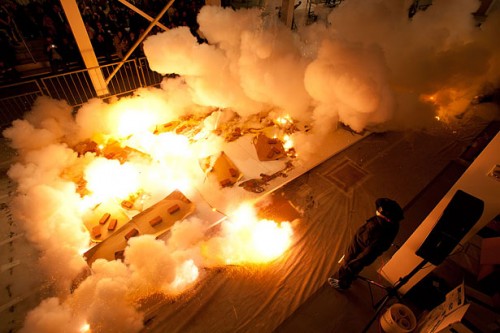
Ignition of gunpowder drawing Desire for "Zero Gravity," Los Angeles, 2012. Photo by Joshua White, JW Pictures.com, courtesy The Museum of Contemporary Art, Los Angeles.
If Cai’s method of creating the work is like lovemaking, then the fruits of his labor, exhibited in Sky Ladder, radiate a warm post-climactic placidity. Though the imagery found in the three gunpowder drawings commissioned by MOCA often depicts violence, the fluid contours and subtle monochromatic shifts of each drawing feel peaceful and understated. Arguably, Cai’s most successful gunpowder drawing is Chaos in Nature (approx. 11 x 49 feet). Here, he allows the images to become unified and atmospheric, rather than relying on the more literal pictographs and clear-cut symbols that disjointedly dominate Zero Gravity (approx. 11 x 39 feet) and Childhood Spaceship (13 feet high x 108 feet wide).
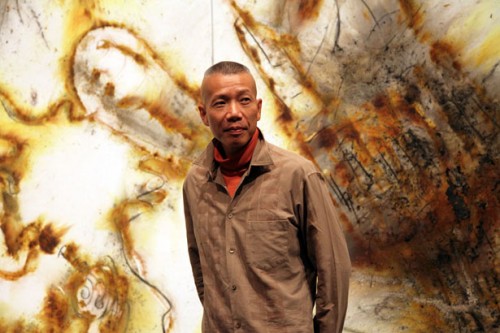
Cai Guo-Qiang with "Chaos in Nature," Los Angeles, 2012. Photo by Joshua White, JW Pictures.com, courtesy The Museum of Contemporary Art, Los Angeles.
Despite the shock and awe of his pyrotechnic process, Cai’s brilliance shines brightest in Crop Circle, an installation that he created without any fire or explosions. Using millions of reeds, Cai simulates the same iconic crop circle pattern left by the residue of Mystery Circle, his fascination with the phenomenon initially sparked by the famous circle patterns burned into a farm field in Alton Barnes, Wiltshire, England, in 1990. The piece, which spans the entire length of MOCA Geffen’s south gallery, hangs upside down from the ceiling. Hence, viewers absorb the piece by walking beneath it and looking up—inverting the classical aerial view of most crop circle photographs. If Mystery Circle forced me to face my own mortality, Crop Circle, with its immersive sprawl and clear evidence of painstaking labor, confronted me with the expansiveness of time and infinite scale of the universe.
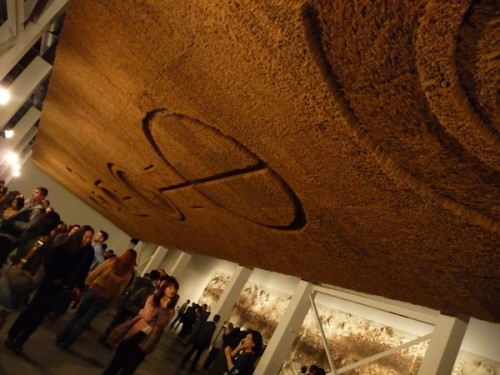
Cai Guo-Qiang, "Crop Circle," 2012. Commissioned by Museum of Contemporary Art Los Angeles, courtesy Hyperallergic.com.



